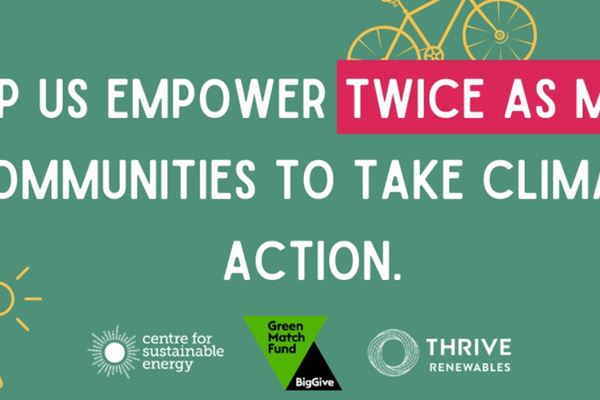According to RenewableUK (RUK) doubling the UK’s onshore wind capacity to 30GW by 2030 would reduce consumer bills by £16.3 billion, generate £45 billion of economic activity and create 27,000 full-time jobs in the UK.
While it sounds like a no-brainer, the government failed to include any tangible target for onshore wind – something that has been widely criticised, especially given the fact that it’s one of the cheapest and fastest ways to build new renewable capacity. Below we summarise the government’s ‘woolly’ commitments to onshore wind and explore how we can continue supporting the roll-out of this technology.
UNPICKING THE ENERGY SECURITY STRATEGY
It was disappointing to see the government miss an opportunity to unleash the full power of onshore wind. Instead of supporting widespread acceleration through changes to planning regulations, the government has said that it will be consulting on how to develop partnerships with ‘a limited number of supportive communities who wish to host new onshore wind infrastructure in return for guaranteed lower energy bills’.
The problem with this is that we know from the government’s own research that support for onshore wind is widespread, so we will need to understand how the government plans on categorising this ‘limited number of supportive communities’. Of course, we are very keen to engage with the consultation to help build new onshore wind for those that want it – something which is currently extremely challenging for them to do in England.
There was also a nod to repowering, with the government consulting on how it can facilitate the replacement of machines at the end of their life with new, more efficient models. Again, quite how this unfolds is yet to be seen but repowering has the potential to generate much more power from an existing site and, if we don’t get this right, the UK’s fleet of renewables could shrink over the next 15 years rather than grow at the pace required.
We undertook the exercise at our Caton Moor wind farm, replacing ten old turbines with eight more modern, efficient machines. As a result, we were able to increase generation sevenfold to 47 million units of electricity per annum.
COMMUNITIES ARE ON BOARD WITH WIND
For many years there has been an assumption that the British public do not like onshore wind, something that David Cameron used to his advantage when introducing an effective ban back in 2015. This could not be further from the truth. In fact, at over 75%, public support for onshore wind is high and this is true across the political spectrum, with 88% of Lib Dem voters in favour of the technology, followed by 83% of Labour voters and 79% of Conservative voters. According to the Opinium poll carried out on behalf of the Observer, two thirds of respondents would also be happy for a windfarm to be built near them.
We’ve witnessed first-hand the positive impact onshore wind can have on host communities. We’ve recently provided a £4 million loan to Ambition Community Energy, enabling the community in Bristol to get their 4.2MW wind project – the tallest in England – into construction. Once built, the turbine will produce enough clean electricity to power close to 3,000 homes – equivalent to the domestic use of Lawrence Weston – and will provide a new revenue stream for residents, with 100% of the profits being reinvested into the local area.
While the benefits promise to be great, it hasn’t been a straightforward process for the Ambition Community Energy team. The group first committed to the idea of hosting a wind turbine in 2016 and have had to overcome many challenges since, including the legacy of the 2015 planning restrictions which meant developers had to prove that a project will be built in an area designated for wind and that it’s stated so in the local plan. In this case, planning officers initially recommended a rejection of the community-owned turbine, but Bristol City Council’s planning committee voted unanimously in its favour. Because of these restrictions, the project also had to be submitted to the Secretary of State for final approval, despite the fact there was unanimous support from the community.
The government has rightly identified that communities do need to be supportive of local onshore wind as part of its energy security strategy, but just how that support will be defined is still up for discussion. Current planning policy makes it difficult for local authorities to approve these types of projects, with research by Dr Rebecca Windemer, lecturer in environmental planning at the University of West England, finding that new wind farms can’t be developed in 89% of local authorities in England. Moving forwards, we’d be looking for the government to make regulation changes that better support local planning authorities and ensure those who are in favour of wind can get it built.
We will certainly be doing everything we can to help communities generate their own power from wind – not only helping to lower energy bills amid soaring wholesale gas prices, but creating the infrastructure needed to support a homegrown, clean energy system in the UK.
MOVING FORWARDS WITH ONSHORE WIND
It's no secret that the government has missed a huge opportunity to maximise the onshore wind projects that are ready-to-go in the UK but, while we wait for the consultations on community engagement and repowering, we’d now like to see attention turn to the fourth Contracts for Difference (CfD) auction which is due to take place soon.
Since the government initially set out its intentions for the auction, a number of things have changed. Specifically, consumer bills have risen drastically due to the gas price crisis and invasion of Ukraine, and its own energy security strategy set out a target of achieving 95% low carbon power by 2030. We’re supporting RUK in its More Renewables Today campaign, urging Boris Johnson to secure additional onshore capacity as part of the next CfD auction to produce cheaper, homegrown electricity.
Why does this help? The government’s Contracts for Difference scheme guarantees a set power price over 15 years, reducing the risk for investors and therefore the capital cost for developers. By securing low-cost, long-term clean power supplies for consumers, the CfD insulates households from the volatile costs and price shocks we’ve seen recently. In fact, RUK states that if the fourth CfD allocation round were to secure an additional 2.2GW above the Government’s current ambitions, this would cut consumers’ exposure to gas by a further £1.5bn a year.
It’s also important to remember that solar and onshore wind sites can be built faster than any other form of new electricity generation. That means that shovel-ready onshore wind and solar farms could be providing the UK with clean, low cost, homegrown power as early as next year if the government seizes the opportunity now.




